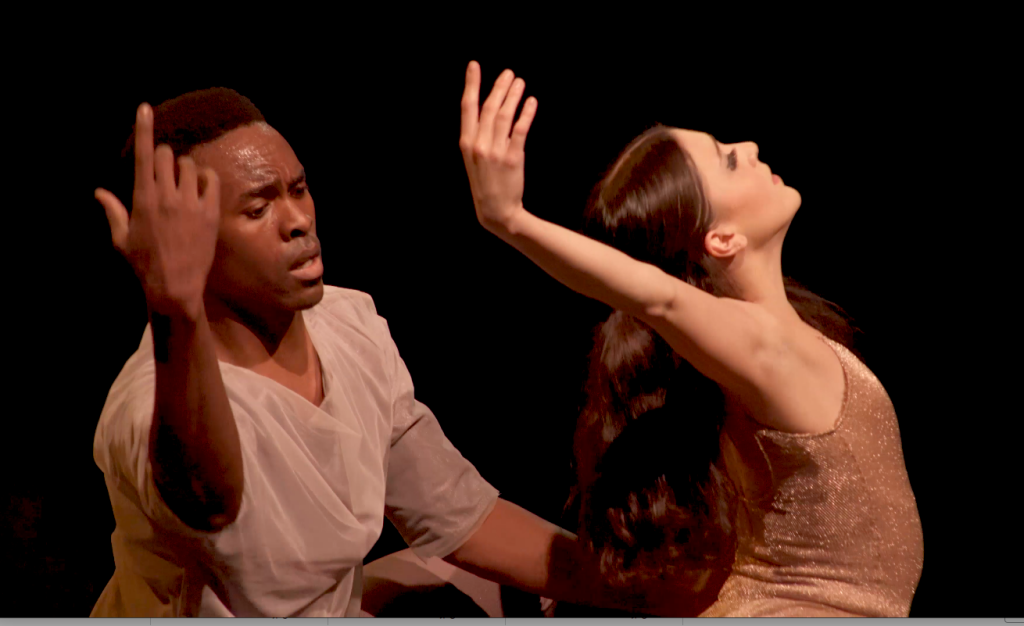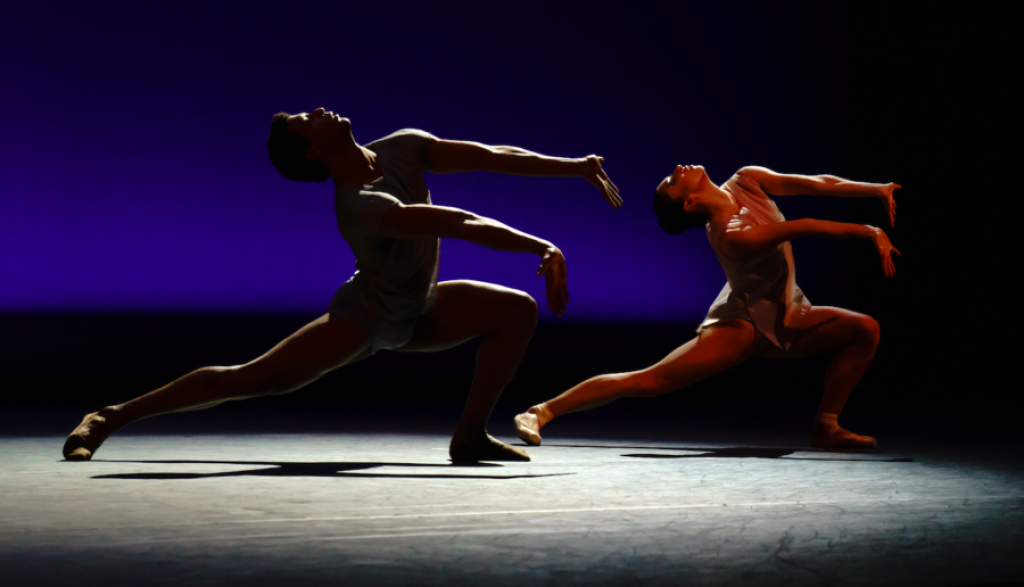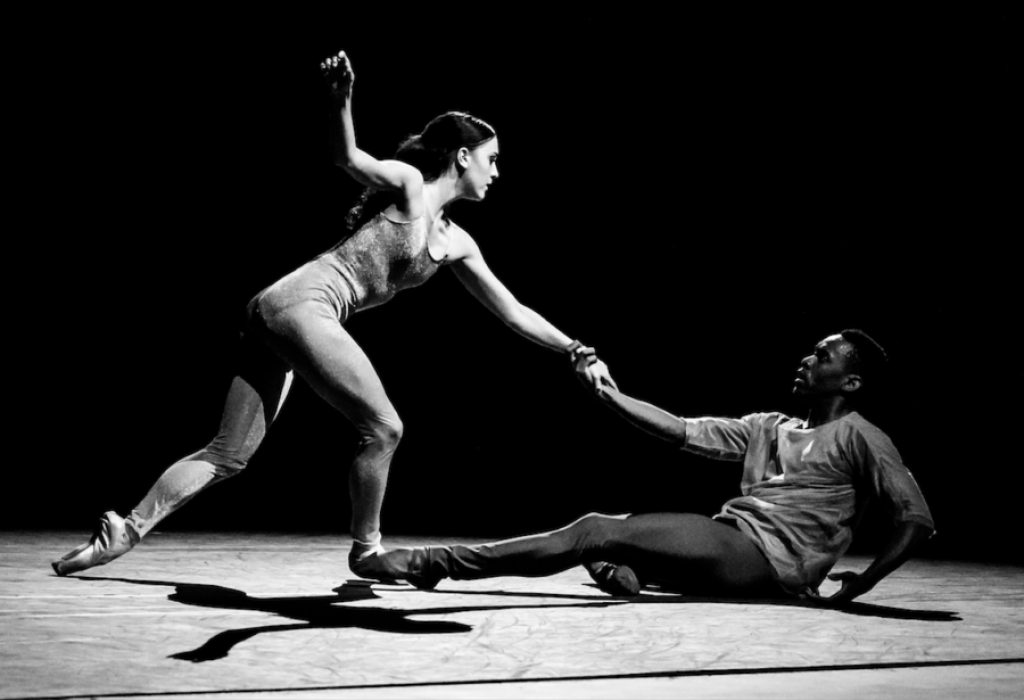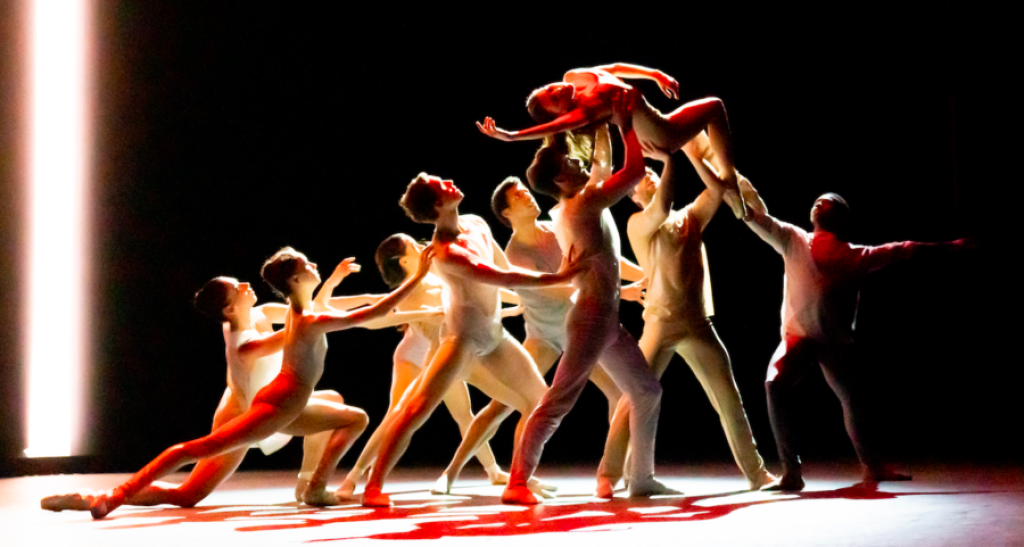Header Photo: Iron Rose Productions for The Washington Ballet
Dr. Natalie Rouland is the Senior Advisor for the Billington Cultural Initiative at the Wilson Center’s Kennan Institute in Washington, D.C. and the 2018 Fellow for the Study of Russia and Ballet at New York University’s Center for Ballet and the Arts and Jordan Center for the Advanced Study of Russia.
The curtain opens on dancers in repose. Diaphanous leotards reveal the curved musculature of necks, spines, and limbs. A vertical bar of white illuminates an otherwise black stage. The muted sound of a jet reverberates across the post-apocalyptic space.
A futuristic feeling pervades Dana Genshaft’s new work Shadow Lands, the centerpiece of the Washington Ballet’s Three World Premieres this April at the Harman Center. Along with Ethan Stiefel’s Wood Work and Trey McIntyre’s Teeming Waltzes, Genshaft’s Shadow Lands represents the Washington Ballet’s initiative to promote new choreographic art. As the 2018 recipient of the Princess Grace Award, Genshaft is a natural choice for Artistic Director Julie Kent. Indeed, the synergy between Genshaft and the Washington Ballet is tangible in the organic, compelling, and haunting force of her first piece for a professional company.
As two dancers roll slowly upstage, the opening notes of Omnivorous Furniture activate the angular clusters of dancers poised on the perimeter. The dancers slink in time to the electronica symphony by Mason Bates, the inaugural Composer in Residence of the Kennedy Center. The cutting-edge score by Bates hearkens back to the avant-garde cinema of Dziga Vertov in his 1929 Man With a Movie Camera, and Genshaft confirms that this film was an inspiration in her choreographic process. Dancers slide, slouch, launch themselves into shifting geometric patterns, slip apart, and come back together again.
[embed]https://www.instagram.com/p/Bv4Q6CNlF-D/?utm_source=ig_web_button_share_sheet[/embed]
The pared-down, stark, and strange modernism of Genshaft’s vision brings to mind George Balanchine’s Agon, by way of The Four Temperaments. The geometric precision and playfully-articulated elegance of her choreographic language elicits Balanchine’s landmark leotard ballets, a resonance which is underscored by Genshaft’s choice of New York design duo Reid Bartelme and Harriet Jung for minimalist, millennium-chic costumes.
A native of Moscow, Genshaft is a Balanchine for the new millennium. Her work presents an edgier version of Balanchine’s St. Petersburg neoclassicism, filtered through the jazzy cool of Jerome Robbins and the electronic abstraction of William Forsythe. Unlike Balanchine, who left the Soviet Union in 1924 as an adult and spent a decade creating ballets in Europe before co-founding the School of American Ballet in 1934, Genshaft immigrated to New York as a child in 1989. She studied at the School of American Ballet before continuing her training at the Kirov Academy in Washington, D.C. and the Paris Opéra Ballet School.
Genshaft joined the San Francisco Ballet in 2000, where she performed as a soloist until 2015 and where she was first encouraged to choreograph by Yuri Possokhov, Choreographer in Residence and former Bolshoi Ballet principal. Her early choreographic works include the 2016 “Portrait” on George Sand for SFDanceworks as well as pieces for the San Francisco Dance Film Festival and the American Ballet Theatre’s studio company.
Genshaft’s émigré experience is evident in Shadow Lands, in which a young woman, the Outlier, enters, disrupts, and is ultimately integrated into an otherworldly clan led by a Circe-like ballerina and her consort. Genshaft recalls the shift between worlds first as a child, taking the train from Coney Island to Lincoln Center to attend classes at the School of American Ballet, and then as an adolescent who “never quite fit in,” partly due to a uniform that differentiated her from the French dancers at the Paris Opéra Ballet School.
This outsider perspective infuses Genshaft’s ballet with a particular piquancy. The Outlier’s estrangement invites audience empathy from her first entrance, when she crouches before the group, arranged in an almost menacing diagonal curve around her.
The role of the Outlier was created especially for the effortless and effervescent Katherine Barkman, compared in her recent performance of Aurora in the Washington Ballet’s new production of The Sleeping Beauty to a young Margot Fonteyn. Barkman shares the Russian Vaganova training that Genshaft cites as her foundation, and both have taken non-traditional, high-risk paths to their current positions.
Barkman’s Outlier is by turns vulnerable, enticing, lyrical, and seductive. Her star power rivals the reigning ballerina around whom the group rotates like the machinery of a clock, and at whose signal they stop as one to look sharply stage left. In rehearsal, Genshaft suggests that they are looking at the sun, a revision of Balanchine dancers in Serenade who shield their eyes from the light of the moon.
The female leader, performed by Kateryna Derechyna and Sona Kharatian, is at one point lifted above the group with her right arm above her head in a position reminiscent of Balanchine’s Siren in Prodigal Son. She literally possesses the power to raise men from the ground, as in the pas de deux when she first pushes down on the back of her consort and then draws him up as if by the same force with which she extends her leg.
The same motion of pressing and releasing may be found in The Four Temperaments, but the agency in Balanchine’s scenario is masculine: in the “Choleric” movement of the ballet, four male dancers place hands on the back of the kneeling female, who springs to life with a soutenu, piqué, arabesque and is then passively rotated on pointe.
The gender dynamic in Genshaft’s work is fluid, with dancers lifting, spinning, dragging, and supporting each other irrespective of hetero-normative hierarchy. In a company led by a female Artistic Director, Kent, and a male Associate Artistic Director, Victor Barbee, this should come as no surprise.
Genshaft’s costumes by Reid & Harriet Design further emphasize the individuality of each dancer and the diversity of the Washington Ballet. The company of thirty-four includes sixteen international dancers and fourteen dancers of color. In the original cast of Agon, Balanchine addressed race in America with his pas de deux between Arthur Mitchell, the first African-American dancer in the New York City Ballet, and the Virginian ballerina Diana Adams. Sixty-two years later, Genshaft’s pas de deux features the Philadelphian Barkman as the Outlier with the South African Andile Ndlovu and the Cuban Javier Morera alternating as the Observer.
The pas de deux between the Outlier and the Observer transpires in the low-lit, lyrical movement of the ballet. Again, moments from previous ballets surface and shimmer, only to be effaced by Genshaft’s innovation. The pas de deux gestures to Robbins’ Afternoon of a Faun in the opening pose of the Observer stretched on his side and in the tentative caresses of the Outlier as she inspires him to dance in a space separate from the group.
Just as Afternoon of a Faun is a dance about dancers, Genshaft’s work becomes a ballet about ballet—the mechanisms that animate but ultimately imprison the art, and the individual’s urge to break free. The Outlier’s lifts by the Observer embody the freedom of balletic flight. And the swimming lesson from Balanchine’s Apollo, in which the ballerina rests on the male dancer’s back, is transformed when the Outlier neatly somersaults over the Observer’s shoulder.
The ending of Shadow Lands is ambiguous. Following their pas de deux, the Outlier and the Observer shift back and forth in a slow-motion run. The Outlier exits stage right, while the Observer is held back and suspended in a static position. The Outlier rejoins the group dynamic and at the culmination is raised aloft in an almost sacrificial pose.
Like the Hegelian spiral of history that preserves what it overcomes, Genshaft’s ballet is a translucent shell in which the classical tradition is both visible and contained. A space-age relic rising from the ruins of twentieth-century ballet, Dana Genshaft’s Shadow Lands is vital, beautiful, resplendent, transcendent.






